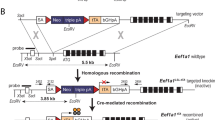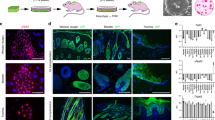Abstract
The ErbB2 receptor tyrosine kinase (RTK) is expressed in basal cells of squamous epithelia and the outer root sheath of hair follicles. We previously showed that constitutive expression of activated ErbB2 directed to these sites in the skin by the keratin 14 (K14) promoter produces prominent hair follicle abnormalities and striking skin hyperplasia in transgenic mice. However, perinatal lethality precluded the establishment of a transgenic line for analysis of ErbB2 function in adult animals. To investigate the significance of ErbB2 signaling in epithelial tissues during and post development, we developed a K14-rtTA/TetRE-ErbB2 `Tet-On' bitransgenic mouse system. These mice were normal until the ErbB2 transgene was induced by exposure to doxycycline (Dox). Prenatal induction resulted in perinatal death. Postnatally, ErbB2 transgene expression was observed at 4 h after the initiation of Dox, and reached a plateau at 24 h. Skin hyperplasia followed after 2 days and these changes reverted to normal upon Dox withdrawal. In adults, as in the neonates, prolonged ErbB2 induction caused prominent skin and hair follicle hyperplasias. Severe hyperplasias in the cornea, eye lids, tongue and esophagus were also observed. ErbB2 transgene induction was accompanied by increased expression of TGFα, a ligand of epidermal growth factor receptor (EGFR), and to a lesser extent, EGFR, further enhancing RTK signal transduction. We conclude that ErbB2 plays important roles in both development and maintenance of hair follicles and diverse squamous epithelia and that this ligand-inducible and tissue-specific `Tet-On' transgenic mouse system provides a means to study transgenes with perinatal toxicity.
This is a preview of subscription content, access via your institution
Access options
Subscribe to this journal
Receive 50 print issues and online access
$259.00 per year
only $5.18 per issue
Buy this article
- Purchase on Springer Link
- Instant access to full article PDF
Prices may be subject to local taxes which are calculated during checkout








Similar content being viewed by others
References
Arbeit JM, Munger K, Howley PM and Hanahan D. . 1994 J. Virol. 68: 4358–4368.
Bargmann CI, Hung MC and Weinberg RA. . 1986 Nature 319: 226–230.
Bailleul B, Surani MA, White S, Barton SC, Brown K, Blessing M, Jorcano J and Balmain A. . 1990 Cell 62: 697–708.
Bjorge JD, Paterson AJ and Kudlow JE. . 1989 J. Biol. Chem. 264: 4021–4027.
Bouchard L, Lamarre L, Tremblay PJ and Jolicoeur P. . 1989 Cell 57: 931–936.
Carraway KL III and Cantley LC. . 1994 Cell 78: 5–8.
Cheng J, Turksen K, Yu Q-C, Schreiber H, Teng M and Fuchs E. . 1992 Genes Dev. 6: 1444–1456.
Cheng S, Schmidt-Grimminger D-C, Murant T, Broker TR and Chow LT. . 1995 Genes Dev. 9: 2335–2349.
Clark AJL, Ishi S, Richert N, Merlino GT and Pastan I. . 1985 Proc. Natl. Acad. Sci. USA 82: 8374–8378.
Coffey Jr RJ, Derynck R, Wilcox JN, Bringman TS, Goustin AS, Moses HL and Pittelkow MR. . 1987 Nature 328: 817–820.
Davis BM, Lewin GR, Mendell LM, Jones ME and Albers KM. . 1993 Neuroscience 56: 789–792.
Dougall WC, Qian X, Paterson NC, Miller MJ, Samanta A and Green MI. . 1994 Oncogene 9: 2109–2123.
Earp HS, Austin KS, Blaisdell J, Rubin RA, Nelson KG, Lee LW and Grisham JW. . 1986 J. Biol. Chem. 261: 4777–4780.
Efrat S, Fusco-DeMane D, Lemberg H, Emran OA and Wang X. . 1995 Proc. Natl. Acad. Sci. USA 92: 3576–3580.
Ewald D, Lim M, Efrat S, Auer G, Wall RJ, Furth PA and Hennighausen L. . 1996 Science 273: 1384–1386.
Furth PA, St Onge L, Boger H, Gruss P, Gossen M, Kinstner A, Bujard H and Hennighausen L. . 1994 Proc. Natl. Acad. Sci. USA 91: 9302–9306.
Guo L, Yu Q-C and Fuchs E. . 1993 EMBO J. 12: 973–986.
Herber R, Liem A, Pitot H and Lambert PF. . 1996 J. Virol. 70: 1873–1881.
Kistner A, Gossen M, Zimmermann F, Jerecic J, Ullmer C, Lubbert H and Bujard H. . 1996 Proc. Natl. Acad. Sci. USA 93: 10933–10938.
Kokai Y, Cohen JA, Drebin JA and Greene MI. . 1987 Proc. Natl. Acad. Sci. USA 84: 8498–8501.
Kudlow JE, Cheung M and Bjorge JD. . 1986 J. Biol. Chem. 261: 4134–4138.
Luetteke NC, Qiu TH, Peiffer RL, Oliver P, Smithies O and Lee DC. . 1993 Cell 73: 263–278.
Mansuy IM, Mayford M, Jacob B and Bach E. . 1998 Cell 92: 39–49.
Maguire Jr HC, Jaworsky C, Cohen JA, Hellman M, Weiner DB and Green MI. . 1989 J. Invest. Dermatol. 89: 786–790.
Mann GB, Fowler KJ, Gabriel KM, Nice EC, Williams RL and Dunn AR. . 1993 Cell 73: 249–261.
Mayford M, Bach ME, Huang Y-Y, Wang L, Hawkins RD and Kandel ER. . 1996 Science 274: 1678–1683.
Miettinen PJ, Berger JE, Meneses J, Phung Y, Pederson RA, Werb Z and Derynck R. . 1995 Nature 376: 337–341.
Murillas R, Larcher F, Conti CJ, Santos M, Ullrich A and Jorcano JL. . 1995 EMBO J. 14: 5216–5223.
Padhy LC, Shih E, Cowing D, Finkelstein R and Weinberg RA. . 1982 Cell 28: 865–871.
Press MF, Cordon-Cardo C and Slamon DJ. . 1990 Oncogene 5: 953–962.
Saitou M, Sugal S, Tanaka T, Shimouchi K, Fuchs E, Narumiya S and Kakizuka A. . 1995 Nature 374: 159–162.
Shih C, Padhy LC, Murray M and Weinberg RA. . 1981 Nature 290: 621–624.
Sibilia M and Wagner EF. . 1995 Science 269: 234–238.
Takahashi K, Folmer J and Coulombe PA. . 1994 J. Cell. Biol. 127: 505–520.
Tanaka S, Mori M, Akiyoshi T, Tanaka Y, Mafune K, Wands JR and Sugimachi K. . 1997 Cancer Res. 57: 28–31.
Threadgill DW, Dlugosz AA, Hansen LA, Tennenbaum T, Lichti U, Yee D, LaMantia C, Mourton T, Herrup K, Harris RC, Barnard JA, Yuspa SH, Coffey Jr RJ and Magnuson T. . 1995 Science 269: 230–234.
Turksen K, Kupper T, Degenstein L, Williams I and Fuchs E. . 1992 Proc. Natl. Acad. Sci. USA 89: 5068–5072.
Vassar R and Fuchs E. . 1991 Genes Dev. 5: 714–727.
Wang X-J, Greenhalgh DA, Eckhardt JN, Rothnagel JA and Roop DR. . 1994 Mol. Carcin. 10: 15–22.
Wang X, Zinkel S, Polonsky K and Fuchs E. . 1997 Proc. Natl. Acad. Sci. USA 94: 219–226.
Williams IR and Kupper TS. . 1994 Proc. Natl. Acad. Sci. USA 91: 9710–9714.
Wysolmerski JJ, Broadus AE, Zhou J, Fuchs E, Milstone LM and Philbrick WM. . 1994 Proc. Natl. Acad. Sci. USA 91: 1133–1137.
Xie W, Paterson AJ, Chin E, Nabell LM and Kudlow JE. . 1997a Mol. Endocrinol. 11: 1766–1781.
Xie W, Su K, Wang T, Paterson AJ and Kudlow JE. . 1997b Anticancer Res. 17: 2627–2634.
Xie W, Chow LT, Wu X, Chin E, Paterson AJ and Kudlow JE. . 1998 Cell Growth Differ. 9: 313–325.
Yu Z, Redfern CS and Fishman G. . 1996 Circ. Res. 79: 691–697.
Acknowledgements
This work was supported by Public Health Service Grant DK48882 and DK43652 from the National Institutes of Health (to JE Kudlow) and LT Chow is supported by USPHS grant CA36200. The authors wish to thank Dr WR Staggers for cloning of K14 promoter, Dr P Jolicoeur for ErbB2 cDNA, and J Clark for his help in developing Dox administration protocol.
Author information
Authors and Affiliations
Rights and permissions
About this article
Cite this article
Xie, W., Chow, L., Paterson, A. et al. Conditional expression of the ErbB2 oncogene elicits reversible hyperplasia in stratified epithelia and up-regulation of TGFα expression in transgenic mice. Oncogene 18, 3593–3607 (1999). https://doi.org/10.1038/sj.onc.1202673
Received:
Revised:
Accepted:
Published:
Issue Date:
DOI: https://doi.org/10.1038/sj.onc.1202673
Keywords
This article is cited by
-
Sensory nerve niche regulates mesenchymal stem cell homeostasis via FGF/mTOR/autophagy axis
Nature Communications (2023)
-
Skin-resident immune cells actively coordinate their distribution with epidermal cells during homeostasis
Nature Cell Biology (2021)
-
Comparative gene expression profiling reveals key pathways and genes different in skin epidermal stem cells and corneal epithelial cells
Genes & Genomics (2019)
-
Sperm-borne miR-449b influences cleavage, epigenetic reprogramming and apoptosis of SCNT embryos in bovine
Scientific Reports (2017)
-
A role for ErbB signaling in the induction of reactive astrogliosis
Cell Discovery (2017)



